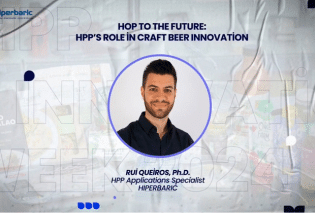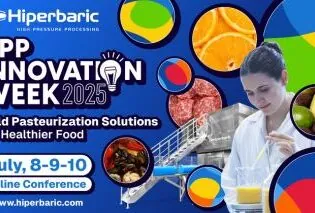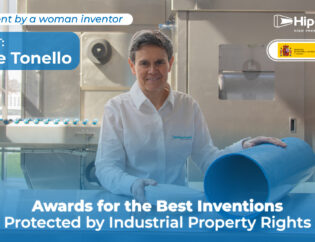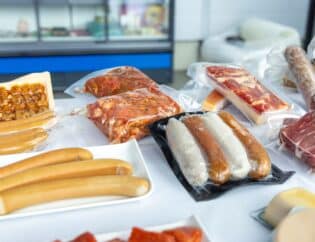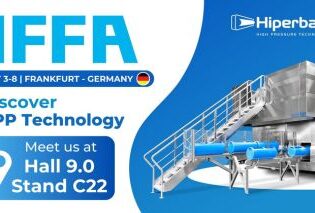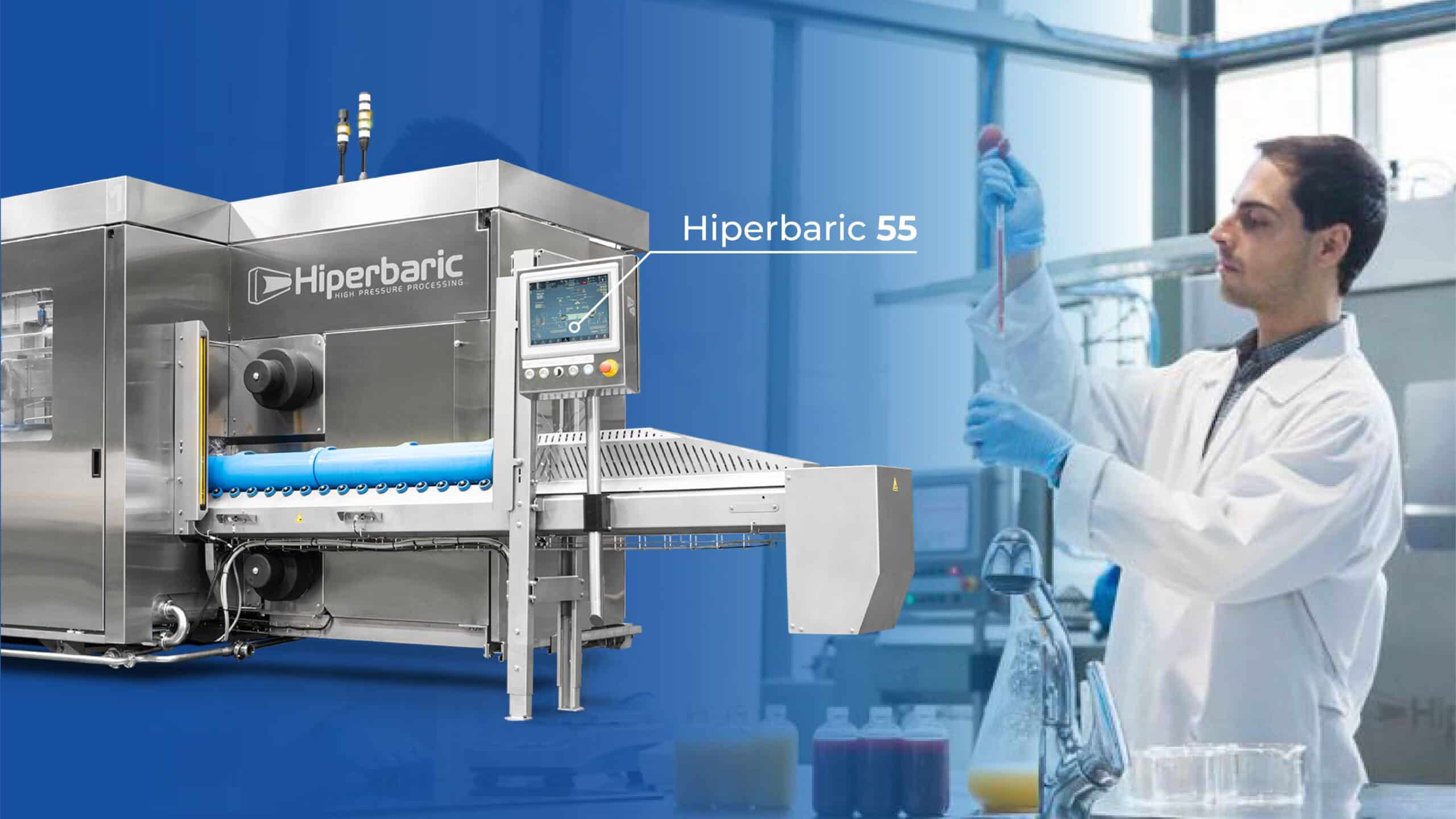
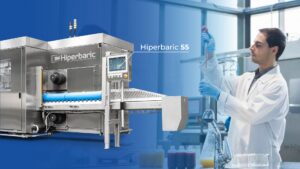
High Pressure Processing (HPP) technology was first introduced by the food industry in Japan in the early 1990’s, but it took more than 100 years of research in food and material sciences to reach the commercial scale. The acquisition of laboratory-scale HPP units may seem an economical option for research purposes, but it has notable limitations from industry product development. The widespread implementation of HPP technology nowadays gives rise to new challenges that require of applied research. Read on to find out how Hiperbaric can help.
The Quick Evolution of High Pressure Processing (HPP)
It is usually not easy to trace the origin of certain processes that human beings dominate today. However, since pressure was an unexplored thermodynamically parameter in food systems until the late XIX century, it is quite simple to establish the roots leading to its current applications (Figure 1)
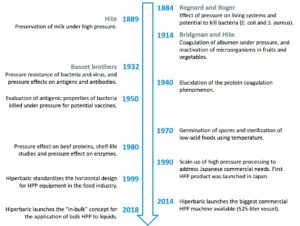
Engineering and material limitations prevented the industrial scale application of this process in the food industry. However, strong efforts were conducted in Japan in the late 80’s and early 90’s to address two main concerns: (i) the difficulty to use ionizing radiation on food, and (ii) the preservation of organoleptic properties of the raw materials in agreement with the Japanese cooking cultur. (Rivalain et al. 2010).
This interest combined with the acquired knowledge from the manufacturers of Cold Isostatic Pressing (CIP) systems used in the alloy and ceramic industries facilitated the development of commercial High Pressure Processing (HPP) units for food applications (Tonello-Samson et al. 2020). The first HPP commercial product was launched in Japan in 1990 and it consisted of fruit jam preparations (Figure 2).
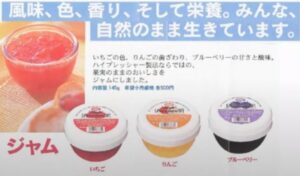
The range of commercial applications rapidly expanded to fruit juices (France, 1994), avocado products (USA, 1996) and meats (Spain, 1998) (González-Angulo et al. 2020). This pushed equipment manufacturers to quickly improve HPP systems as follows:
- Horizontal configuration to increase productivity, convenience and traceability
- Quicker pressure build-up time to increase throughput
- Bigger pressure vessels to accommodate more product
However, research to understand the principles behind HPP technology was mainly performed by universities and research centers all around the world. For reasons of convenience, or due to economic or logistical constraints, most of these institutions use laboratory-scale equipment. The use of such equipment may have some implications that should be considered for process scaling-up.
Industrial HPP Equipment for the Food Industry
Meeting consumer demands is essential to drive industry growth and business development. Thus, research institutions must never lose sight of industry practices to remain relevant.
Typical HPP conditions in the food industry range 400-600 MPa/58,000-87,000 psi with 1-5 min pressure holding time, at chilled or temperature (4-25 °C/39-77 °F) using equipment with 55 to 525 liter vessel capacity.
Laboratory scale equipment may not be able to reach this maximum operating pressure. Other units may be designed to operate at even greater pressure levels, but both cases do not have relevant applications for industrial practice and would potentially increase maintenance costs. In addition, other parameters such as compression or decompression rates may differ from the equipment used by the food industry.
Process validation
The use of pilot scale equipment becomes critical when research institutions work in collaboration with food safety authorities to establish specific regulations for HPP foods (Podolak et al. 2020). This fact motivated some research institutions to acquire a Hiperbaric 55 industrial unit. The HPP Validation Center (Figure 3) at Cornell University has conducted extensive research to characterize and select appropriate pathogen strains for the validation of different food systems (juices, meats, vegetables, etc.).
The industrial Hiperbaric 55 equipment enables them to perform robust pathogen challenge studies for different companies to comply with FDA and USDA regulations in the United States. From 2017 to 2021, the institution performed more than 500 pathogen challenge studies and over 700 shelf life studies for different companies (see “How to Validate Your HPP Products”).
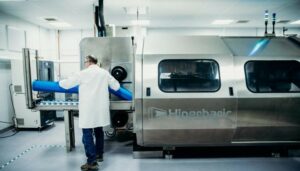
Applied Research
In addition to food safety, the pilot scale Hiperbaric 55 is widely used research projects with direct commercial impact.
The University of Aveiro in Portugal has one of the most productive scientific groups researching pressure effects in food and biosystems. One of the latest research projects resulted in the successful development of the “Serra de Estrela”/ “Quejio Serra da Estrela”, an endemic cheese produced in the mountain region of Portugal, and under Protected Designation of Origin in Europe and the UK (see “HPP opportunities for the dairy industry: case study on Serra da Estrela cheese”).
The Institute of Agrifood Research and Technology (IRTA) in Girona (Spain) has a long history of applied research that has been fundamental for the safe establishment of meat products, particularly premium fermented and cured meats like Serrano ham. Nowadays IRTA researchers are evaluating HPP on raw animal-derived products intended for companion animals consumption (see HPP Research Awards 2022: Development of a tool to evaluate the efficacy of HPP to guarantee food safety of acidulated raw pet food).
Likewise, the pilot-plant scale equipment HPP and freeze-drying capabilities at the Food Processing Center (FPC) of the University of Nebraska-Lincoln to lead research efforts for the HPP pet food and other categories (see “Challenges and Research Advances of HPP for Pet Food”).
Packaging validation
Packaging plays a critical role in HPP food products as it is related to food safety, shelf life, marketing, filling efficiency of HPP equipment and transportation. Thus, to validate the adequacy of the final package is a critical step in product development.
The vessel of laboratory equipment range from less than 1 milliliter up to 10 liters that use mostly pouches for testing, due to the inability of fitting commercial packaging formats into the equipment (Queirós et al. unpublished).
Industrial or pilot-scale HPP equipment overcome the packaging size limitations of laboratory units as they can accommodate the whole range of HPP packaging formats that include bottles, pouches, Bag-In-Box, tubs, trays, trays with MAP, bulk pouches and containers (Serment-Moreno et al. 2020).
Unlimited packaging options with industrial HPP units allow members of the Hiperbaric HPP Academia Network to help with the product development of customers in their respective pilot plants (Table 1).
Table 1. Members of the HPP Academia Network using Hiperbaric’s industrial HPP equipment for product development and/or process validation.
High Pressure Thermal Processing for the Food Industry
The combination of high pressure (up to 600 MPa/87,000 psi) and high temperature levels (up to 121 °C/250 °F) in a process called High Pressure Thermal Processing (HPTP) allows spore inactivation for shelf stable foods. In this regard, the FDA has issued no objection letters for the production of mashed potato and multi-component foods using this process.
Whereas HPTP research is typically conducted at laboratory scale, no commercial applications have emerged yet. Several limitations may prevent process scale-up:
- Operation and maintenance reduce throughput.
- Preheating and cooling of product and equipment require time and energy.
- Temperature uniformity under pressure inside industrial vessels.
Few industrial machines can operate under such pressure and temperature conditions. The Hiperbaric 55-liter vessel unit at AZTI (Spain) is probably one of the few horizontal industrial machines able to reach 630 MPa/91,370 psi and 130 °C/266 °F (Sevenich & Mathys, 2018) (Figure 4).
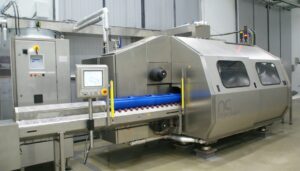
Although industrial and pilot-scale HPTP equipment is available, the abovementioned limitations may prevent implementation by the food industry. To overcome them, Hiperbaric is working with research center CSIRO (Australia) to develop insolated canisters and temperature sensors that will make HPTP cost-effective and easy to control (Knoerzer et al. 2015). The inside layers provide insulation and ensure a homogeneous temperature (up to 121 °C/250 °F) to the products that fill the canister, while protecting the components of industrial HPP equipment operating with pressurizing fluid (water) in the 4-25 °C/39-77 °F range with horizontal vessel design (Figure 5).
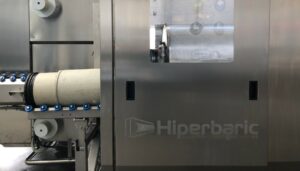
Vessel configuration (vertical vs. horizontal) is another major consideration since most research evaluating HPTP is conducted on equipment with lab- or pilot-scale vertical vessels. However, temperature distribution differs from the horizontal vessel design used by the HPP industry (Smith et al. 2014). Horizontal vessels display a more uniform temperature profile than vertical units, but temperature distribution varies radially (Salvi et al. 2017). Hence, larger vessel diameters result in a more heterogeneous temperature distribution, which represents a challenge for the control of critical process parameters (Smith et al. 2014).
Overall, the quick adoption of High Pressure Processing technology by the food industry was made possible by research of universities and research centers using lab- or pilot-scale machines. However, the use of industrial equipment for R&D can facilitate the development of new products, compliance with current regulations or validation of new processes.


